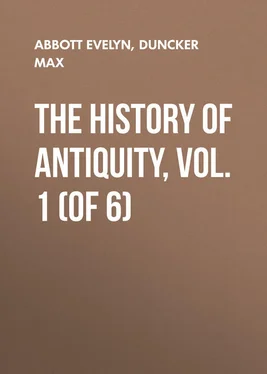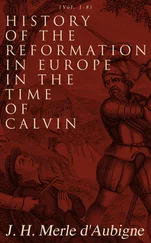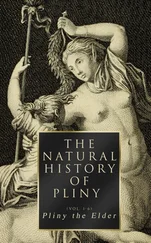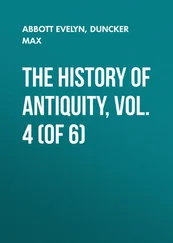Evelyn Abbott - The History of Antiquity, Vol. 1 (of 6)
Здесь есть возможность читать онлайн «Evelyn Abbott - The History of Antiquity, Vol. 1 (of 6)» — ознакомительный отрывок электронной книги совершенно бесплатно, а после прочтения отрывка купить полную версию. В некоторых случаях можно слушать аудио, скачать через торрент в формате fb2 и присутствует краткое содержание. Жанр: foreign_antique, foreign_prose, Историческая проза, на английском языке. Описание произведения, (предисловие) а так же отзывы посетителей доступны на портале библиотеки ЛибКат.
- Название:The History of Antiquity, Vol. 1 (of 6)
- Автор:
- Жанр:
- Год:неизвестен
- ISBN:нет данных
- Рейтинг книги:5 / 5. Голосов: 1
-
Избранное:Добавить в избранное
- Отзывы:
-
Ваша оценка:
- 100
- 1
- 2
- 3
- 4
- 5
The History of Antiquity, Vol. 1 (of 6): краткое содержание, описание и аннотация
Предлагаем к чтению аннотацию, описание, краткое содержание или предисловие (зависит от того, что написал сам автор книги «The History of Antiquity, Vol. 1 (of 6)»). Если вы не нашли необходимую информацию о книге — напишите в комментариях, мы постараемся отыскать её.
The History of Antiquity, Vol. 1 (of 6) — читать онлайн ознакомительный отрывок
Ниже представлен текст книги, разбитый по страницам. Система сохранения места последней прочитанной страницы, позволяет с удобством читать онлайн бесплатно книгу «The History of Antiquity, Vol. 1 (of 6)», без необходимости каждый раз заново искать на чём Вы остановились. Поставьте закладку, и сможете в любой момент перейти на страницу, на которой закончили чтение.
Интервал:
Закладка:
The variations of these tables from the lists may be explained by assuming that it depended on the particular view and peculiar object of the kings who erected these monuments, which of their predecessors they wished to honour, and which they wished to exclude. But even a manuscript list of kings, which has come down to us, exhibits numerous and very considerable variations from Manetho's lists. This list is a papyrus, now in Turin, supposed to belong to the period 1500-1000 B.C. It begins with the rule of the gods; then follow the names of the kings, with the length of their reigns in years, months, and days, down to the time of the Tuthmosis; and thus it includes the first seventeen dynasties of Manetho's list. It has been much damaged, and therefore we can only discover that about 240 names were given, of which, however, about 100 are entirely gone; and of the others the lesser half at least is hardly legible. As has been remarked, Manetho numbers at least 284 kings to the eighteenth dynasty. Moreover, the papyrus does not agree with Manetho in the division of the dynasties; at certain places, which do not coincide with the sections of Manetho, totals are given of the preceding reigns. The first king after the gods is Mena (Menes), but of the names which follow only a few agree with those in Manetho, and a few more with those of the tables of Karnak, Abydus, and Sakkarah. 23But here also the same names occupy different places in the series.
If in addition to all these variations and discrepancies we add the fact that even in the contemporary monuments and inscriptions which have come down to us there is no lack of contradictions to Manetho's statements – if too these monuments have not been erected or preserved in sufficient continuity, nor are of a sufficiently ample kind, to form an adequate check upon the papyrus of Turin, or the tables of kings or the list of Manetho – we must give up the hope of ascertaining the antiquity and course of Egyptian history on such data. One thing only comes out clear and irrefragable from the tables of Karnak, Abydus, and Sakkarah, no less than the Turin papyrus. Long before Herodotus was in Egypt, long before Manetho wrote his Egyptian history, in the fifteenth century B.C. Menes was considered the first king of Egypt. Even then lists of the kings were in existence, and the priests had made a sketch of the history of their land, in which the rule of the gods preceded the rule of human kings.
Modern research has attempted in various ways to find the key to the puzzle of these long and confused series of kings made by the Egyptian priests. Assuming that the names of the kings and the length of their reigns, and the number of reigns belonging to each dynasty, has been handed down correctly by Manetho, but that some of these dynasties were contemporaneous, the attempt has been made to give such a selection from the dynasties of Manetho as would supply a continuous thread for Egyptian history. Thus from the dynasties expressly marked as Memphitic, or Theban, a series may be formed which shortens the calculation of Manetho by at least 1,000 years. We might proceed further in this direction, and reduce Manetho's list by 2,000 or 3,000 years. According to the separate items in the excerpts preserved, Manetho's thirty dynasties include a series of 5,366 Egyptian years (from the year 5702 to the year 340 B.C.); nevertheless, Syncellus, in a passage of his Chronology, has observed that the whole period of history treated by Manetho in his three books covered 3,555 years. 24This observation has been used to prove that Manetho himself arranged several dynasties contemporaneously; and thus, by taking the whole total of years given by Syncellus as a basis, the year 3892 B.C. has been fixed as the first year of the reign of Menes. No doubt a selection may be made from the dynasties of Manetho in such a way that the sum total of the reigns included in it will carry us no farther back than this year. 25But it is clear from the accounts of Herodotus and Diodorus that the series of kings made by the Egyptian priests were strictly successive; and this fact is abundantly confirmed by the Turin papyrus and the excerpts preserved from Manetho himself. The 3,555 years which Syncellus brings forward cannot, in the face of his own excerpt, be taken as a number really derived from Manetho, and with this number all the calculations founded upon it fall to the ground. 26
A second path, which has lately been struck out for the reduction of Manetho's dynasties, is based upon the list of Eratosthenes. The thirty-eight kings enumerated in this list are placed beside the first fourteen dynasties of Manetho. It is assumed that only the names quoted in Eratosthenes are the names of real monarchs, and that we must look for similar names in the list of Manetho. By this assumption, it is true, we are compelled to set aside several of Manetho's dynasties, and even to throw away the greater part of the kings of the dynasties which are allowed to count in the series. 27But even when we have overcome all the difficulties in the way of this system, we are still without the means to define accurately the duration of the rule of the alien kings, which, as has been already remarked, according to the various excerpts from the list of Manetho, continued 953, or 511, or 103 years; nor is there any fixed point immediately before the alien monarchy to enable us to succeed in establishing the antiquity and commencement of the Egyptian series of kings.
All attempts to arrive at the antiquity of the civilisation and history of Egypt by these means are the more doubtful, because in Egypt there is no fixed era to form a basis for calculation. The time is reckoned by the reigns of the kings. In such a case even the most cautious inquiry of the priests could hardly have arrived at a satisfactory chronology for the oldest period. Though they had before them far more numerous monuments than we have, and though the lists of the various dominant families began to be kept at a very early period, it was no longer possible at the time when the lists of the Turin papyrus were made out, to discover in what order the families came, or which ruled contemporaneously before the time of the alien kings. The mere arrangement of our materials in the order of succession cannot fail to give an entirely false picture of the history of Egypt, while on the other hand the national pride of the Egyptians, and the vanity of the priests, found a great satisfaction in exaggerating the antiquity of their history by such enumerations, even where it was known that any families of kings were contemporaneous. With what pride and complacency would they exhibit this endless list of kings to the travelling strangers from Greece!
Besides the want of a fixed era, and the insufficient knowledge of the ancient period, and of the alien monarchy – besides the motives of national vanity, there was another remarkable circumstance connected with the priests of Egypt which was calculated to lead them far away from historical truth. The Egyptians measured time by a solar year of 360 days, divided into twelve months of thirty days. It was early observed that this year did not correspond to the sun's orbit; and therefore five additional days were added. The decisive event of the Egyptian year was the inundation. The Nile began to rise at the time of the summer solstice, and was coincident with the rising of the Dog-star (Sothis), the brightest star in the Egyptian sky. The Dog-star proclaimed the approach of the inundation and the new fertilization of the soil, and by proclaiming caused it. Thus to the Egyptians this star Sothis was "the Lady of the Beginning." The rising of the star denoted the new year; which therefore must have begun on the 20th July, the first of Thoth in the Egyptian calendar. But since, in the Egyptian year, a quarter of a day was wanting, in spite of the additional five years, to make up the true astronomical year, the beginning of every fourth year must have been a day in advance of the true year, and the seasons, of which the Egyptians made three of four months each, the months, and the festivals anticipated more and more the true time of the year. This advance could not have escaped the priests; they must soon have observed that a period of 1,461 Egyptian years must elapse in order to allow the Egyptian year to coincide with astronomical time. For in 1,460 Egyptian years the additional quarter of a day in the astronomical year would amount to 365 whole days — i. e. to an Egyptian year; and at the end of this year the beginning of the next was again coincident with the rising of the Dog-star, as seen from Lower Egypt, and the commencement of the inundation. Thus in a period of 1,461 years the year was again brought to its true beginning. 28Since the fruitfulness and life of the Egyptian land depended on the inundation, and the inundation began with the rising of the Dog-star, the history of Egypt must also have begun with a similar rising. If after 1,461 Egyptian years the rising of the Dog-star again coincided with the beginning of the civic year, the priests would regard this restoration of the natural order as the completion of a great cycle of events. The Dog-star brought the inundation, and with it the fruits and life of Egypt. It was the awakener of life. It must therefore have brought life to the world also; time must have begun with the rising of Sirius. Porphyrius tells us that to the Egyptians the rising of the Dog-star was the beginning of the world. 29Hence the periods of the world must proceed according to a number of periods fixed by the Dog-star. It seems that the priests comprised the whole duration of the world in twenty-five Sothis periods, i. e. in 36,525 Egyptian years. Regarded in this light, the Sothis periods of the priests of Egypt must lead to a cyclic treatment of their history, to which also the want of any definite era was forcing them, while the antiquity and number of the lists of kings offered abundant material for it. The history of Egypt must comprise a definite number of Sothis periods. It was known that in the fourteenth century B.C. such a period ended, and a new one commenced; the difficulty was to fill up two or three periods anterior to this. Before the Sothis period of the kings, the gods had ruled over Egypt, to whom, therefore, a number of Sothis cycles, naturally more extensive than those given to the rule of men, was allotted. Thus the priests of Thebes were able to tell Herodotus that, from the time when the Twelve Gods ruled over Egypt, down to the days of King Amosis, 17,000 years had passed; that from Menes, down to Sethos, 341 kings ruled in succession over Egypt, and that in this space of time the sun had four times risen in an unusual way – it had twice risen where it then set, and had twice set where it then rose; and nothing in Egypt had been changed by this, either in the gifts of the earth or the river, in sickness or in mortality. 30This change of the rising and setting of the sun is nothing more than the symbolical astrology of the priests, who must have expressed the completion of the movable solar year by the opposite quarters of the sky; and it means no more than that two Sothis periods had elapsed between Menes and Sethos; but to Herodotus the statement as given naturally appeared quite incredible. 31What the priests told Herodotus, Manetho, following far older authorities, had already fixed in a systematic form before Diodorus found that the gods ruled 18,000 years, and the human kings had begun to reign 4,700 years before his arrival in Egypt. To the gods and demigods Manetho allows twelve Sothis periods, i. e. 17,520 Julian years. Then follows the history of the men, the beginning of which Manetho places in the commencement of that period of the Dog-star which begins with the year 5702 B.C. From this point the series of kings runs through three complete Sothis periods down to Menephta; in the fourth period Manetho closed the lists of his thirty dynasties with the last native ruler in 340 B.C., the 984th year of the fourth Sothis period of the human kings. Thus it would be possible to make the scheme clear on which the priests of Egypt dealt with the history of their land, and the lists of Manetho would then lay claim to complete historical credibility for the ancient periods in isolated items, though certainly not in their combination as a whole.
Читать дальшеИнтервал:
Закладка:
Похожие книги на «The History of Antiquity, Vol. 1 (of 6)»
Представляем Вашему вниманию похожие книги на «The History of Antiquity, Vol. 1 (of 6)» списком для выбора. Мы отобрали схожую по названию и смыслу литературу в надежде предоставить читателям больше вариантов отыскать новые, интересные, ещё непрочитанные произведения.
Обсуждение, отзывы о книге «The History of Antiquity, Vol. 1 (of 6)» и просто собственные мнения читателей. Оставьте ваши комментарии, напишите, что Вы думаете о произведении, его смысле или главных героях. Укажите что конкретно понравилось, а что нет, и почему Вы так считаете.












